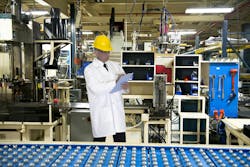How to Upgrade Quality Control for Better Performance
It’s hard to overstate the importance of manufacturing quality. Reliable quality control (QC) processes ensure regulatory compliance, prevent costly production mistakes and lead to better-performing products for greater customer satisfaction.
While most manufacturers likely recognize the need for thorough quality assurance, many still rely on insufficient processes. Here’s how organizations can upgrade their QC for better long-term performance.
Design for Manufacturability
Better quality assurance begins before production even starts. Engineers must tackle product design from a long-term perspective, considering the manufacturability of their designs. The easier it is to create a product, the less likely production mistakes will be.
Artificial intelligence (AI) is a potential game-changer in this regard. AI can analyze the complex relationships in large datasets to balance multiple design considerations, including manufacturability, and then generate mockups accordingly. Consequently, these tools reduce trial and error to provide high-quality designs in less time.
Getting input from multiple stakeholders across the manufacturing process can also help. More collaborative design phases lead to production workflows that account for various needs and potential issues. That consideration makes errors and manufacturing obstacles less likely.
Use Digital Twins in the Design Phase
Digital twins can also be a huge help in the design phase. These virtual models enable fast but reliable simulations to find and fix issues before they arise in prototyping or full-scale production.
Unlike conventional digital models, digital twins use real-world data to inform their design and performance. This connection to the real world lets engineers see how various materials or complete designs hold up under varying conditions. They can then refine the product to maximize its performance before production.
READ MORE: Computer Vision Transforms Production and Quality Control
This approach to design has two main advantages in QC. First, addressing issues early and accurately leads to more reliable products. The sooner you can catch and fix flaws, the less time and money you’ll spend doing so. Secondly, these simulations are faster and use fewer resources than real-world tests, ensuring higher quality assurance doesn’t sacrifice cost-efficiency.
Test Parts and Materials Before Assembly
Once production begins, many manufacturers focus their QC efforts on end-of-line inspections. While these are important, they’re not enough on their own. The most effective QC systems prevent defects as early as possible, which requires preassembly inspections of parts and materials.
Preassembly testing methods should be both fast and reliable. Vibration testing is one of the most effective ways to gauge the durability of many parts or materials. Machine vision is efficient and enough for flaws with visual cues. Material defects will create larger problems down the line. By catching these early, one can ensure subpar materials or components don’t go into production, minimizing the losses they’d cause.
Train Employees Thoroughly
Material defects are not the only cause of QC issues. Many mistakes arise from human error during production, so it’s important to address this area, too. One of the most critical steps to prevent these mistakes is to thoroughly train employees.
READ MORE: Subjective Quality Testing is Becoming a Thing of the Past
Develop clear, specific standards for how workers should perform each job and what their finished products should look like. The more standardized these processes and goals are, the easier it is to ensure compliance with best practices. It may help to review past defect data to find the most common mistakes, which can inform tips or new standards to emphasize in training.
Even experienced employees can become complacent and forget or overlook some standards. You can prevent this through periodic refresher training and surprise inspections.
Design Workflows to Be Error-Resistant
Even with thorough training, mistakes can still happen. An often-overlooked way to address that issue is to make errors harder to make. Production workflows should feature enough standardization and safety stops so that there’s less room for errors to occur in the first place.
Placing parts in blocks that orient them the same way every time can eliminate misalignment mistakes. Calibrating equipment so power tools only deliver the force required to screw in a component and stop at that point prevents undue mechanical stress.
Automation is another key resource in eliminating opportunities for mistakes, as it minimizes the possibility of human error. The most time-consuming or error-prone processes are typically the best use cases for automation, so turn to robotics for these tasks. Placing workers before robots to ensure any parts they work with are oriented correctly will further minimize mistakes.
Automate QC Where Possible
Production isn’t the only process that can benefit from automation, either. Automating end-of-line QC inspections can yield significant improvements in product reliability and overall efficiency.
Human employees, regardless of their talents or experience, can get distracted or tired, causing them to miss some defects. Manual inspections are also slow, creating bottlenecks at the end of the production line. Automating these checks through machine vision or other AI-assisted nondestructive testing addresses both sides of the issue.
READ MORE: Using Digital Processes to Enhance Safety and Quality
Some machine vision algorithms can analyze thousands of parts per hour, enabling QC at the speed of production. Because these systems compare each product to the same standards in every instance, they also deliver consistent accuracy.
Analyze QC Data Trends Over Time
A more tech-centric, AI-enabled QC process will produce more digital data over defect trends than conventional alternatives. Manufacturers should use this information to their advantage and analyze it to uncover larger issues.
AI analyses may find that most errors arise from one task in the workflow, suggesting that changing it could prevent future mistakes. Alternatively, they could pinpoint where QC inspections take too long with minimal value added. This ongoing review and adjustment will increase QC cost efficiency over time.
Manufacturers have already seen significant savings from AI-assisted QC optimizations. Some have cut material waste by 90% by deploying AI inspections throughout the production line to prevent errors before they cause larger issues. That potential is hard to ignore.
Better Quality Control Leads to Better Products
Improved quality assurance workflows will prevent regulatory run-ins and ensure you put out higher-quality products. Your company will develop a reputation for reliability and performance as a result. Costs and waste will also decline.
These strategies are not the only way to upgrade your QC, but they’re some of the most important. Take these ideas, right-size them into your specific workflows and slowly adjust over time to reap the fullest benefits.
Emily Newton is a technology and industrial journalist. She is also the editor-in-chief of Revolutionized. She has more than five years covering stories about warehousing, logistics and distribution.
About the Author

Emily Newton
Emily Newton is a technology and industrial journalist. She is also the editor in chief of Revolutionized. She has over five years covering stories about warehousing, logistics and distribution.
